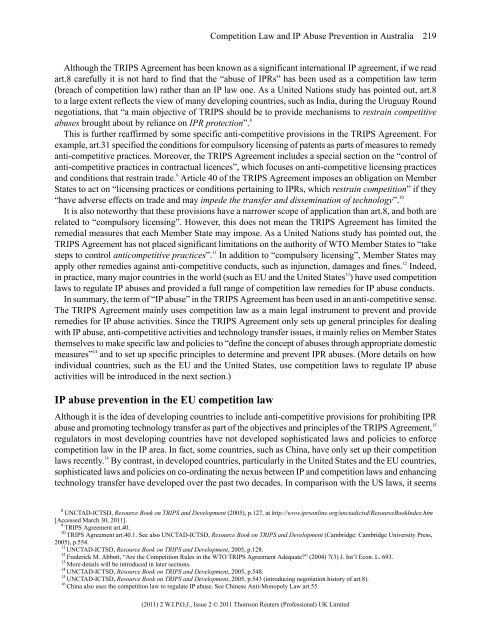WIPO Journal - World Intellectual Property Organization
WIPO Journal - World Intellectual Property Organization
WIPO Journal - World Intellectual Property Organization
Create successful ePaper yourself
Turn your PDF publications into a flip-book with our unique Google optimized e-Paper software.
Although the TRIPS Agreement has been known as a significant international IP agreement, if we read<br />
art.8 carefully it is not hard to find that the “abuse of IPRs” has been used as a competition law term<br />
(breach of competition law) rather than an IP law one. As a United Nations study has pointed out, art.8<br />
to a large extent reflects the view of many developing countries, such as India, during the Uruguay Round<br />
negotiations, that “a main objective of TRIPS should be to provide mechanisms to restrain competitive<br />
abuses brought about by reliance on IPR protection”. 8<br />
This is further reaffirmed by some specific anti-competitive provisions in the TRIPS Agreement. For<br />
example, art.31 specified the conditions for compulsory licensing of patents as parts of measures to remedy<br />
anti-competitive practices. Moreover, the TRIPS Agreement includes a special section on the “control of<br />
anti-competitive practices in contractual licences”, which focuses on anti-competitive licensing practices<br />
and conditions that restrain trade. 9 Article 40 of the TRIPS Agreement imposes an obligation on Member<br />
States to act on “licensing practices or conditions pertaining to IPRs, which restrain competition” if they<br />
“have adverse effects on trade and may impede the transfer and dissemination of technology”. 10<br />
It is also noteworthy that these provisions have a narrower scope of application than art.8, and both are<br />
related to “compulsory licensing”. However, this does not mean the TRIPS Agreement has limited the<br />
remedial measures that each Member State may impose. As a United Nations study has pointed out, the<br />
TRIPS Agreement has not placed significant limitations on the authority of WTO Member States to “take<br />
steps to control anticompetitive practices”. 11 In addition to “compulsory licensing”, Member States may<br />
apply other remedies against anti-competitive conducts, such as injunction, damages and fines. 12 Indeed,<br />
in practice, many major countries in the world (such as EU and the United States 13 ) have used competition<br />
laws to regulate IP abuses and provided a full range of competition law remedies for IP abuse conducts.<br />
In summary, the term of “IP abuse” in the TRIPS Agreement has been used in an anti-competitive sense.<br />
The TRIPS Agreement mainly uses competition law as a main legal instrument to prevent and provide<br />
remedies for IP abuse activities. Since the TRIPS Agreement only sets up general principles for dealing<br />
with IP abuse, anti-competitive activities and technology transfer issues, it mainly relies on Member States<br />
themselves to make specific law and policies to “define the concept of abuses through appropriate domestic<br />
measures” 14 and to set up specific principles to determine and prevent IPR abuses. (More details on how<br />
individual countries, such as the EU and the United States, use competition laws to regulate IP abuse<br />
activities will be introduced in the next section.)<br />
IP abuse prevention in the EU competition law<br />
Competition Law and IP Abuse Prevention in Australia 219<br />
Although it is the idea of developing countries to include anti-competitive provisions for prohibiting IPR<br />
abuse and promoting technology transfer as part of the objectives and principles of the TRIPS Agreement, 15<br />
regulators in most developing countries have not developed sophisticated laws and policies to enforce<br />
competition law in the IP area. In fact, some countries, such as China, have only set up their competition<br />
laws recently. 16 By contrast, in developed countries, particularly in the United States and the EU countries,<br />
sophisticated laws and policies on co-ordinating the nexus between IP and competition laws and enhancing<br />
technology transfer have developed over the past two decades. In comparison with the US laws, it seems<br />
8<br />
UNCTAD-ICTSD, Resource Book on TRIPS and Development (2005), p.127, at http://www.iprsonline.org/unctadictsd/ResourceBookIndex.htm<br />
[Accessed March 30, 2011].<br />
9<br />
TRIPS Agreement art.40.<br />
10<br />
TRIPS Agreement art.40.1. See also UNCTAD-ICTSD, Resource Book on TRIPS and Development (Cambridge: Cambridge University Press,<br />
2005), p.554.<br />
11<br />
UNCTAD-ICTSD, Resource Book on TRIPS and Development, 2005, p.128.<br />
12<br />
Frederick M. Abbott, “Are the Competition Rules in the WTO TRIPS Agreement Adequate?” (2004) 7(3) J. Int’l Econ. L. 693.<br />
13<br />
More details will be introduced in later sections.<br />
14<br />
UNCTAD-ICTSD, Resource Book on TRIPS and Development, 2005, p.548.<br />
15<br />
UNCTAD-ICTSD, Resource Book on TRIPS and Development, 2005, p.543 (introducing negotiation history of art.8).<br />
16<br />
China also uses the competition law to regulate IP abuse. See Chinese Anti-Monopoly Law art.55.<br />
(2011) 2 W.I.P.O.J., Issue 2 © 2011 Thomson Reuters (Professional) UK Limited

















